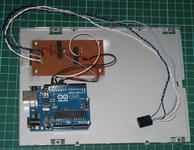New Leffakone Timer
Traduction: [ Google | Babelfish ]
Catégories : [ Bricolage/Arduino | TV/Leffakone ]

I finally built the timer for the new Leffakone. It is based on an Arduino Uno, which controls two reed relays and one LED. The reed relays can be activated with a very low current (10 mA), meaning that the Arduino can drive them directly from any I/O pin. The relays' contacts are connected in parallel to the power button and the reset button. The Arduino's serial-over-USB port is connected to one of the USB headers of the motherboard with a home-made cable, and the timer is set by software through this serial connection. All the wires coming from the computer case's front panel are connected to the circuit (to the 8-pin header protruding from the protoboard), and wires go from there to the motherboard's front-panel header (2 white wires for the power button, 2 grey wires for the reset button, and 2 blue+black wires for the power-on LED. The two boards are screwed on the bottom plate of the case of an old CD drive; for installation, I closed the case and put it into the computer as a regular CD drive.
While the timer is counting down, it blinks the computer case's HDD LED (which therefore is not anymore indicating the HDD activity).
When the timer expires, it closes the power button's relay for 500 ms. An optional watchdog timer would close the reset button's relay if the machine does not boot correctly i.e., if the timer is not reset within 30 s. This watchdog timer is currently disabled in the code, since the problems I have had with GRUB freezing on startup seem to be related to manually powering the device and switching the TV on shortly after. I'll enable it if it seems necessary. Here is the code for the Arduino.
The software client for the timer is written in Python and is very straightforward: send ASCII digits to the serial port, ending with a newline character. It interprets this number as a number of seconds, and starts counting down. When disconnecting the client from the serial port, the Arduino resets and forgets all about the timer value; I found out that setting the DTR line to False in the Python Serial object prevents this from happeining. I haven't however found out how to prevent a reset when connecting to the Arduino; this is less a problem, since when I connect to it, I want to reset the timer, and reseting the whole program does just that. It seems that it's the Linux driver that asserts the DTR line when opening the serial port; I haven't investigated further. It is worth noting that when the machine boots, it does not reset the Arduino.
Finally, the cristal in the Arduino is accurate to 99.5% which is not enough to guarantee that the timer will wake up the computer within a minute after a countdown of several days. I therefore apply a corrective factor to the time sent to the Arduino. The factor was estimated from a 15.5 hour countdown, which lasted about 90s more than it should have. Over a 7-days countdown, it would cause the timer to expire about 16 minutes too late.
[ Posté le 4 mai 2014 à 20:38 | 1 commentaire | lien permanent ]







Several months ago, the leffakone infrared receiver started to misbehave. There were a lot of errors in syslog about spikes in the signal, and the problem seemed to come from the serial port on the motherboard rather than from the homebrew IR receiver, co...